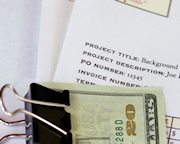Whether the economy is cold or hot, some individuals and organizations wind up filing for Chapter 11 bankruptcy. If you stay in business long enough, some of their names will likely appear on your accounts receivable list. When that happens, don't waste energy being angry or worried.
Depending on the details, if you act fast, you may be able to recoup your shipment of goods, or at least part of the money your company is owed. How much can you collect? If you're a secured creditor, the average is 77 cents on the dollar. Unfortunately, unsecured creditors often collect only two cents on the dollar, so whether or not you decide to take action obviously depends on the size of the receivable. Assuming it's enough to pursue, here's what you need to do.
|
Chapter 11 Defined
|
| Chapter 11 is the form of bankruptcy that permits a debtor to step back, regroup and develop a plan for paying outstanding debts, subject to approval.  When Chapter 11 is filed, an automatic stay prevents creditors from most collection activity and other legal action.
|
Start by getting a solid understanding of the process involved in a Chapter 11 bankruptcy by reading the information in the right-hand box.
Even though time is of the essence for the action you need to take, be patient when it comes to actually getting paid. This is a true "hurry up and wait" scenario, since you must act quickly, but the debtor gets time to regroup and may have years to pay.
As soon as you learn a customer has filed Chapter 11, examine the sales for which your company is owed money.
20 Days from Date of Sale
If the sale was made within 20 days of the customer filing Chapter 11, you may be able to file an administrative claim. This claim is a very important tool, as it establishes priority over general unsecured creditors. In other words, it moves you up in rank when payment is made. Ask your financial or legal adviser to help you with filing an administrative claim. Once this is done, you will also need to file a motion with the court to get the debt recognized and eventually paid.
45 Days from Sale Date
Were the goods sold within 45 days of your customer filing Chapter 11? If the answer is yes, find out if they have been shipped and also received. If the shipment has not yet been delivered, can you halt delivery? If delivery has been completed and you have a legitimate reason to believe your company will not be paid, the Uniform Commercial Code gives you the right to file a reclamation claim to take back the goods.
If this is the case, within 45 days of the delivery, or within 20 days of the initiation of the bankruptcy -- assuming the 45 day period ends after the bankruptcy is filed -- you must send a letter of reclamation. Be careful to include a detailed description of the goods in question so there will be no basis for confusion.
With that done, you'll need to go to bankruptcy court to get an Order of Reclamation. This is an area where an attorney should be consulted.
Next, find out how the debtor has listed the amount your company is owed. Is the amount correct? Does the debtor dispute the amount your records show is owed by qualifying it as "contingent" or "unliquidated?"
If there is a dispute, ask your attorney if it would be wise to file proof of claim. This is a form that creditors use to indicate the amount owed by the debtor on the date of the bankruptcy filing. The proof of claim form must be filed in the same court where the bankruptcy was filed.
Can You Become Part of the Creditors' Committee?
If you are one of the seven largest unsecured creditors, you can ask to be appointed to the Creditors' Committee. Members are appointed by the United States Trustees and help to manage the settling of repayment. Why bother to become a member? Because being part of this committee boosts the chances of getting paid. The Creditors' Committee has the right to be heard as part of the bankruptcy proceedings. The committee is not put in place to run or control the debtor's business. The purpose is to negotiate with all parties involved so that all unsecured creditors — including your company — get the maximum recovery possible.



